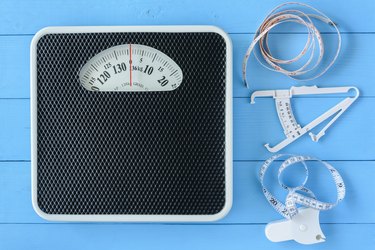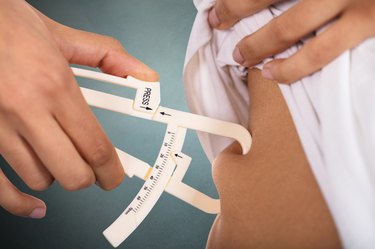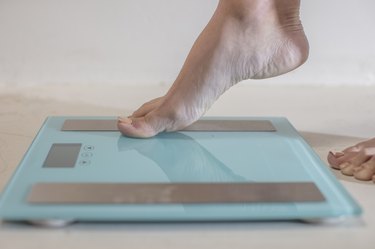
Whether your goal is to win the stage at a bodybuilding competition or simply lose some fat for health reasons, keeping tabs on your body composition is critical to meeting your goals. And measuring your belly fat, in particular, can tell you a lot about where you stand.
There are different types of body fat, but two important ones to note when it comes to belly fat are the visceral and subcutaneous varieties.
Subcutaneous, or soft, fat is the fat that lies just beneath your skin, while visceral, or hard, fat lies deeper inside your body and usually accumulates around your abdominal organs. Reducing both types of belly fat can increase your fitness and improve your overall health, but lowering your visceral fat, especially, can help decrease your risk for chronic conditions such as diabetes and cancer.
The first step to dropping to a healthy amount of belly fat is to find out how much you have. Here, find four different ways to measure your belly fat and the pros and cons of each.
Read more: How to Estimate Your Body Fat Percentage
1. Try a Tape Measure
Old-school but tried-and-true, tape measures may stand as the easiest way to measure belly fat. You can measure any part of your body with a tape measure, but if you want to focus on belly fat, you should measure your waist circumference and/or calculate your waist-to-hip ratio, according to the Harvard T.H. Chan School of Public Health.
Waist circumference: To measure your waist circumference, stand up straight and relax your abdomen. Wear a skin-tight shirt or, better yet, don't wear one at all. Wrap the tape measure around your core just above your belly button; it should be snug, but not so snug that any skin is bulging over the tape measure. Make sure you've exhaled before noting the measurement.
A waist size greater than 35 inches for women and 40 inches for men can increase your risk for obesity-related illnesses like heart disease and type 2 diabetes, per the National Institutes of Health.
Waist-to-hip ratio: To find your waist-to-hip ratio, first measure your waist as described above. Then measure your hips by wrapping the tape measure around the widest part of your buttocks. Calculate your waist-to-hip ratio by dividing your waist circumference by your hip circumference.
For example, if your waist circumference is 30 and your hip circumference is 40, your waist-to-hip ratio would be 30 divided by 40, or 0.75.
According to the World Health Organization, healthy waist-to-hip ratios are 0.85 or less for women and 0.9 or less for men.
To make measuring even easier, you can even find smart tape measures on the market, like PIE by Bagel Labs, which automates accurate measurements and connects to a smartphone app. Once you wrap the tape measure around your waist or hip, PIE sends the measurement to your phone via the app, where it logs all of your measurements and even presents time graphs to show your progress.
While this method of measuring body fat offers easy-to-understand results over time, it's important to note that tape measures aren't foolproof. Measuring this way is subject to user error and faulty conditions, such as being bloated. To minimize errors, consider having a trained professional take your measurements and ensure that testing conditions are the same for each measurement.

2. Ask a Professional to Help You Use Skinfold Calipers
Considering how inexpensive skinfold calipers are, they provide surprisingly accurate body fat readings, according to the American Council on Exercise. Skinfold calipers are one of the most common methods used by professional personal trainers and provide readings that compete with more high-tech, expensive options, per the ACE.
To measure belly fat with skinfold calipers, stand up straight and remove or lift your shirt. Exhale and relax your belly. Pinch your fat and pull it away from your muscles, attach the calipers, and record the measurements. You can enter your measurements into an online calculator or look at a standard skinfold caliper chart (which usually comes with the purchase of calipers) to find your fat percentage.
For the most accurate results, make sure to pinch and test the same area every time you use skinfold calipers. A personal trainer or other fitness professional can help you get better results. Also, keep in mind that the equations for skinfold caliper measurements usually spit back a number meant to represent your overall body fat percentage, not just your belly fat. But using this number in combination with your waist measurement or waist-to-hip ratio can give you a clearer picture of how much of your body fat resides in your midsection.
If you are interested only in measuring belly fat, you can still use skinfold calipers, but your best bet is to keep track of the actual measurements in millimeters (shown on the calipers) and disregard the equations. You'll know that you're losing belly fat if the millimeter measurements get smaller over time.
3. Invest in Dual-Energy X-ray Absorptiometry (DEXA)
Considered by many fitness professionals to be the gold standard in body composition testing, per a June 2017 study in Clinical Nutrition, a DEXA exposes you to different frequencies of X-ray energy to gather many different measurements, including bone density, lean body mass and fat mass. The DEXA machine measures your body compartmentally, meaning one area at a time, so it differentiates your abdomen from the rest of your body.
During a DEXA scan, you'll lie on a table for about 10 minutes while the X-ray arm passes over your body. You'll pay for the accuracy, though: DEXA scans are typically only available at health facilities and can run upwards of $150 per scan. Due to the high cost, this may not be the best choice if you want to measure your belly fat regularly to monitor your progress.
4. Grab a 3D Body Scanner
This class of body fat measurement systems only recently became available to the public for at-home use and is sure to keep growing in the future. Also called digital anthropometry, 3D body scanners use sensors, a camera, a scale and a turntable to create a 3D model of your body — the result is a scary-accurate, 360-degree visual representation of your body, along with corresponding measurements.
The Naked body scanner, for example, measures nine areas of your body, including your stomach, so you can easily keep track of body fat in certain regions. Most 3D body scanners give you measurements in both percentages and circumferences (such as of the waist), so you have multiple numbers to help you establish a clear picture.
While this new technology is impressive, it still has some drawbacks. Clothes, for instance, can seriously wreck your results. It might feel awkward, but your best bet is to stand in front of a 3D body scanner completely naked. If that won't work for you, tight pants (like leggings) and a tight top will also work, but make sure to wear the same outfit every time you scan.
There's also cost to consider: The Naked body scanner will set you back more than $1,000, making it a substantial investment.
Read more: 8 Ways to Beat Stress-Induced Belly Fat

What About Smart Scales?
Like 3D body scanners, smart scales are relatively new in the health and fitness world. These scales are kind of like an all-in-one measurement system that monitors your body weight, BMI and body composition.
The problem with smart scales, though, is that they typically use bioelectrical impedance analysis (BIA), which can often report inaccurate readings, according to an October 2018 review in the European Journal of Nutrition. BIA involves sending a weak electrical current through your body and then using a mathematical formula to estimate your total lean body mass. But the electrical current can be thrown off very easily — if you just drank a cup of water, for example, your results might be skewed because of the way electrical currents travel through water.
Also, most smart scales won't tell you how much fat you have on your belly, specifically. Rather, they lump everything into one overall body fat percentage. With all that said, smart scales probably aren't the best option for measuring belly fat.
Tips for Getting Accurate Measurements
If you plan to measure your belly fat more than once, make sure that you use the same method each time — that's how you'll get the most accurate results. Regardless of which method you choose, using the same one consistently offers better insights to your progress.
For example, if you measure your waist-to-hip ratio every month, you will be able to see clear changes in your measurements as you lose weight or tone up. On the flip side, if you measure your waist-to-hip ratio the first month and then use skinfold calipers the following month, you won't have a baseline with which to compare your caliper measurements.
Additionally, do your best to test your belly fat under the same conditions each time. Factors like hydration, meal timing, time of day, exercise and menstrual cycles can all play into your measurements and body scans.
A good tactic that produces reliable results is to test your belly fat on the first of each month, while well-hydrated, before you've eaten a meal (so first thing in the morning, ideally) and before you've exercised. It might not be possible to test your belly fat under those exact conditions every single time, but try your best!